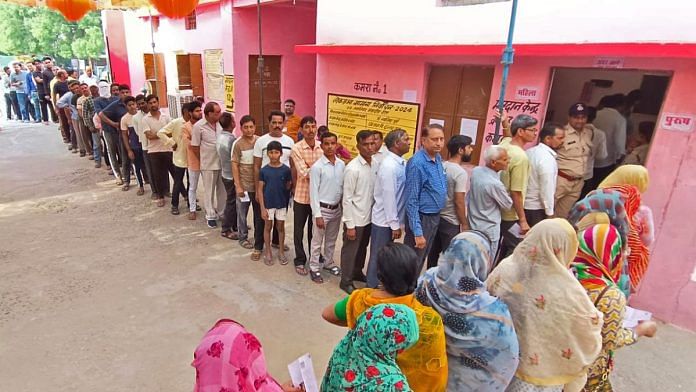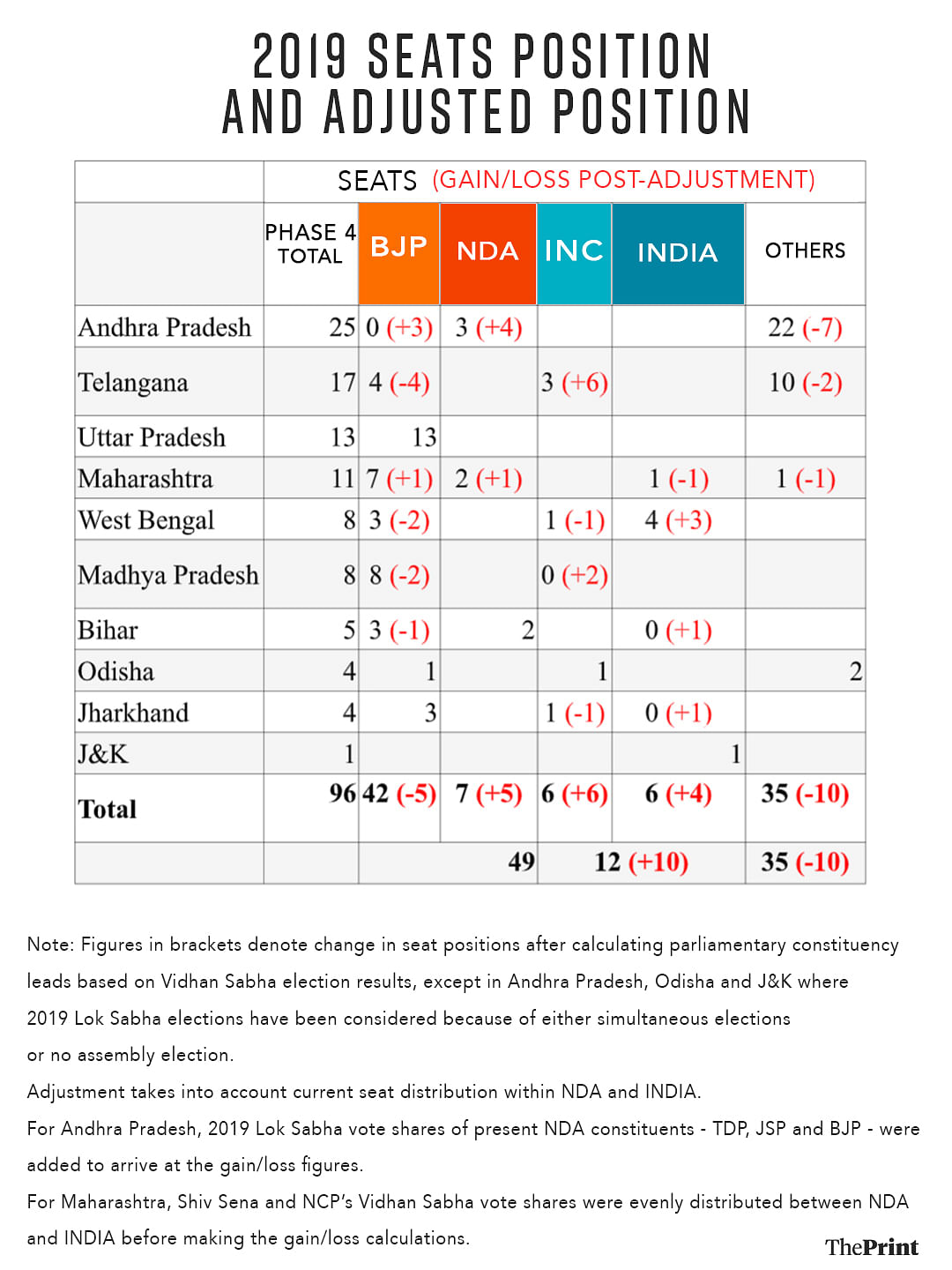The fourth phase, the high-noon of this epic election, invites our attention to a third set of players other than the NDA, the ruling coalition, and INDIA, the main challenger. The ‘non-aligned’ parties could play a critical role in the eventuality of a hung parliament, which looks much more likely than it did one month ago. As we mentioned in the earlier pieces in this series, the NDA may have lost about 40 seats in the first three phases. It would hope to halt that slide in this phase where the NDA vs INDIA contest is a little muted and it can look to make small gains in the Telugu-speaking states to make up for possible losses elsewhere.
Of the 96 seats up for grabs in this phase, powerful state-level parties such as the Yuvajana Sramika Rythu Congress Party (YSRCP) in Andhra Pradesh, the Biju Janata Dal (BJD) in Odisha and the Bharat Rashtra Samithi (BRS) in Telangana can decide the outcome in almost half of them. Overall, 49 seats are currently held by the NDA, with 42 belonging to the BJP and seven to its allies. The majority of these 49 NDA seats are located in Uttar Pradesh, Madhya Pradesh, and Maharashtra. In contrast, the INDIA parties had only secured 12 seats in 2019 that were split evenly between the Congress and other INDIA constituents. This leaves 35 seats, which were won by the non-aligned parties, of which 32 came from Andhra Pradesh and Telangana alone.
Assembly elections held after 2019 do not alter the picture very much. If voters in the fourth phase vote exactly the way they did in the assembly polls (except Andhra Pradesh and Odisha where assembly and Lok Sabha polls happened simultaneously), the NDA ends up adding nothing to its tally of 49. INDIA sees an addition of 10 seats to its existing count of 12, taking its total to 22, while the unaffiliated parties fall from 35 to 25.
Also read: Karnataka, Maharashtra—Why Phase 3 could mean BJP falling short of the magic number 272
BJP a weak link in the south
Let us focus on the battlegrounds for this phase. Andhra Pradesh, where Lok Sabha and assembly elections are once again taking place side by side. YSRCP, which had won over four-fifths of the assembly and Lok Sabha seats in 2019, faces a fierce battle (or a Mahabharata as ruling Chief Minister, YS Jagan Mohan Reddy alluded) with the NDA that comprises former three-time chief minister Chandrababu Naidu’s TDP, actor Pawan Kalyan’s Jana Sena Party (JSP) and the BJP.
The YSRCP is mainly banking on its welfare initiatives, the party’s traditional popularity among women, religious minorities and tribal voters, and on consolidating the resentment against the central government’s denial of special status to the state.
The opposition NDA alliance rests its hopes on the anti-incumbency sentiment, the long-pending issue of designating a capital for the state and the arithmetic of the alliance and caste equations, especially support from the 20 per cent strong Kapu community to which Pawan Kalyan belongs.
The YSRCP is stronger in rural areas and southern Rayalaseema region and the TDP-JSP-BJP alliance has an edge in urban areas and northern coastal parts. If we add up the votes of all the present NDA constituents during the 2019 Lok Sabha elections in Andhra, the coalition could gain seven seats over and above the three that the TDP had last time. They would need an additional 3.1 per cent uniform swing in their favour to tilt the scales and a much bigger swing for an NDA sweep to materialise.
The BJP appears to be a weak link within the NDA in this state, though it has managed to secure almost one-fourth of the seats from its alliance partners despite winning less than one per cent of the state’s votes in 2019. The communal utterances by the BJP leaders, including home minister Amit Shah, in the neighbouring state of Telangana are also a liability for this alliance that hopes to gain some Muslim votes. The Congress is hoping to revive its fortunes under the leadership of YS Sharmila, the sister of CM Reddy, but may be well short of converting its vote gains into seats.
In neighbouring Telangana, while the Congress is hoping to carry forward the momentum generated from its assembly election win and is banking on the implementation of many of its election guarantees, it cannot afford to be complacent.
Unlike the assembly elections, it looks like a Congress vs BJP battle in most of the seats. The BRS, which had grown in the last decade primarily by acquiring notable MPs and MLAs from the INC is being paid back in its own coin by both the BJP and the INC. A whopping two-third of the BJP’s contestants are recent acquisitions, mostly from the BRS. The BJP hopes that the influence of these contestants supplemented by the greasy fuel of polarisation will make up for its lack of a base of core voters and cadre.
The INC, which had performed very well in the rural areas but not in the greater Hyderabad urban region, has tried to make up for this by importing influential local BRS MLAs and fielding them as contestants.
What might work in the Congress’s favor in Telangana this time is the consolidation of the Muslim vote behind it and the fatigue of the common man with the rancid brew of polarisation. By all accounts, the Congress is set to substantially improve its last tally of just three seats, while the BJP can, at the most, add a couple of seats. While AIMIM may retain its sole seat, the BRS should be happy if it can retain one or two seats of its nine seats.
Also read: Everyone says ‘aayega to Modi hi’—some with a drumroll, many with despair
Jailed former CM, BJP bastions
In Odisha, where four Lok Sabha seats and 28 assembly seats in the southern interior and coastal part of the state are going to the polls, the stakes are high for both the ruling BJD, and the BJP. All the four seats had seen close contests in 2019 and both parties are trying to generate momentum for the main battle in Odisha which continues through the coming three phases.
The other state that starts voting from this phase is Jharkhand where four out of the 14 seats vote. All four seats are reserved—three for Scheduled Tribes (Singhbhum, Khunti and Lohardaga) located in the southern part of the state and one for Scheduled Castes (Palamu) located in the north. STs and SCs together constitute nearly two-fifths of Jharkhand’s population and it is important for INDIA to start well in these seats to make an impact in the next phases.
In the 2019 Lok Sabha election, the Congress secured the Singhbhum seat but narrowly lost Khunti and Lohardaga to the BJP. In Palamu, the BJP had won with a significant margin over the Rashtriya Janata Dal. The INDIA bloc is hoping that sympathy for Hemant Soren, the jailed popular former CM, can tilt close seats even for the Jharkand Mukti Morcha’s partners.
INDIA’s chances of picking up additional seats are the strongest in West Bengal, and to some extent Madhya Pradesh and Bihar. In West Bengal, the election travels southwards and enters the central part of the state with the constituencies of several high profile contestants. This phase in the state can be described as one of prestige and political survival. Out of a total of eight seats going to polls, INDIA had won five last the time (four by TMC, one by INC) and the BJP had won three. Based on the 2021 assembly election results, TMC has the potential to gain three additional seats at the cost of the INC and the BJP.
In Bihar, where five seats located in and around the Mithila region go to polls, INDIA had drawn a blank the last time. Of these five, it might gain only one if assembly election results get replicated. To make a bigger dent in the NDA’s tally, a swing of 2-3 per cent over the assembly vote shares will be needed, which seems possible.
In Madhya Pradesh, it is the turn of the northern Malwa and tribal Malwa regions to vote this time. If the Congress is able to retain its assembly election vote share and if the miniscule vote secured by its INDIA partner Aam Aadmi Party also comes to it, then it can possibly pick up two reserved ST seats (Dhar and Khargone), and with a small additional push Ratlam as well. Many of the other seats voting in this phase such as Ujjain, Dewas and Indore are BJP bastions where INDIA seems to have lesser chances.
On paper, INDIA’s prospects do not seem too bright in 13 Uttar Pradesh and 11 Maharashtra seats that are going to the polls. In Uttar Pradesh, where elections in this phase are spread over parts of the Doab and Awadh regions and even a small part of north Purvanchal, NDA is well placed in all the 13 going by the 2019 Lok Sabha as well as the the 2022 assembly election results. However, the BJP has retained 11 of its 13 sitting MPs, a move that has invited voters’ anger in many seats where the incumbents’ performance is below par. A mild uniform swing of two percentage points away from the BJP as compared to assembly elections of 2022 will cost the party four seats; a uniform swing of three percentage points away from the BJP will cost it six seats.
In Maharashtra too, the 2019 assembly election results suggest no gains for INDIA even after splitting the Shiv Sena and Nationalist Congress Party vote half and half. If anything, INDIA and AIMIM might end up losing the seats that they hold. A total of 11 seats spread across upper Marathwada, upper Western Maharashtra and North Maharashtra are going to the polls in this phase, of which the BJP and undivided Shiv Sena had won nine the last time. While many of the seats such as Jalgaon, Raver, Jalna, Ahmednagar, Pune and Beed have been BJP strongholds, constituencies where INDIA can produce an upset are Nandurbar, Shirdi and Aurangabad. But INDIA should not expect major gains in this phase.
All in all, this phase could end in a draw. Both the INDIA coalition and the NDA would hope to make modest gains at the expense of the ‘non-aligned’ regional players, without affecting their mutual equation very much.
Yogendra Yadav is National Convener of the Bharat Jodo Abhiyan. He tweets @_YogendraYadav. Shreyas Sardesai is a survey researcher associated with the Bharat Jodo Abhiyan. Rahul Shastri is a researcher. Views are personal.
(Edited by Theres Sudeep)








Red Salute to comrade Yadav
The print is becoming mouthpiece of indi alliance. And trying to manipulate the election.